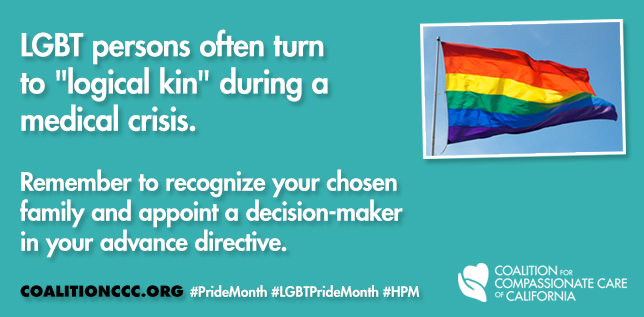End-of-Life Care Discussions Foster Community in the Families We Create
Brian de Vries, PhD, Professor of Gerontology at San Francisco State University
Engaging others in end of life discussions requires intentionality, introspection, and openness.
This is true within traditional family structures, but it is even more crucial among those who are not legally related, including most lesbian, gay, bisexual and transgender (LGBT) persons, and others whose loves and lives defy heteronormativity—a viewpoint that expresses heterosexuality as a given, instead of being one of many possibilities.
As a gay man, gerontologist, and caregiver for a partner living with Parkinson’s disease, I know from both personal and professional experience how important it is to make my healthcare wishes known in advance in the case of an accident or serious illness. Both my partner and I have completed
advance directives—documents that appoint a healthcare power of attorney and make our care preferences known to each other and to those who care about us most.
It seems to me that end-of-life discussions and conversations about future care wishes and concerns in general, often appear among other items on a “grocery list” of activities: go the bank—check; find a lawyer—check; have care discussion with family—check.
Even as this representation has the tone of a caricature, it is distressingly common to hear about the reasons individuals avoid or delay such discussions (
“the timing is not right”) and/or the barriers encountered when such conversations are attempted (we are described as
“maudlin” or hear that that we are speaking
“nonsense” or admonished for
“tempting fate” if we raise such issues).

When these discussions do happen, they most often take place between and among grandparents, parents and their (adult) children—the typical traditional families. The well documented requests for and offers of assistance within this structure form a hierarchy within families: between spouses first, parents and children second, and distant family third. It is only once these “entitled” players have been exhausted (either emotionally or physically), do efforts reach beyond these traditional family forms—into friendship networks and formal services.
LGBT older adults often fall outside these traditional family forms. Many, particularly those now in their later years, were abandoned or neglected by their families of birth, have long been excluded from the institution of marriage and robbed of opportunities to create those family forms recognized by social institutions. As such, large proportions of older LGBT persons reach the very later years alienated from their families of birth without partners, and without children.
In addition, for those LGBT persons of the
Stonewall generation (i.e., those now in their 60’s and older), medical and social service organizations are associated with a history of dismissal and neglect. These LGBT persons lived through times when “gay” was seen as a mental illness (and subject to “curative treatment” from “helpful” medical professionals), and when loving someone of the same sex was seen as an abomination and subject to excommunication from a religious congregation. Turning now, in later life, to these same organizations for support is likely to call up many feelings of resentment and apprehension.
In response, LGBT persons turn instead to their friends, mostly other LGBT persons, forming what Armistead Maupin characterized as “logical kin” to differentiate it from the biological kinship ties of traditional families. But these creative families and friendship ties lack the social gravitas and recognition of traditional families, a model that still dominates in thinking, policy and much practice.
Just as chosen families don’t have to conform to what some might see as limiting roles for enactment (e.g., the “dutiful daughter”), they also lack the rituals, defined roles and social scripts that come into focus at various life junctures. While traditional families (particularly spouses and children) can be sequestered and compelled to listen to or initiate end-of-life conversations, mostly at a critical, and often late, juncture of the individual’s illness, the same is not true of chosen families. It is not always clear who is, or is not, included, and thereby challenging to assemble during a time of crisis. There is less likely a shared identity.
Discussions of end-of-life care include the sharing of hopes, concerns and fears, and are acts of intimacy. Clarifying these issues for ourselves and sharing them with others brings people together. They can help foster community and the families we create.
And, just as during the crisis years of AIDS, the LGBT community can once again show how communities can care and share without conforming to traditional labels and roles—LGBT and beyond.
Find tools to start conversations about end-of-life decisions with your loved ones here.
Brian de Vries, Ph.D., is a Professor of Gerontology at San Francisco State University. He is a fellow of the Gerontological Society of America (GSA), Board member of the American Society on Aging (ASA), co-Chair of the LGBT Aging Issues Network constituent group, and is a policy advisor for the AARP California.